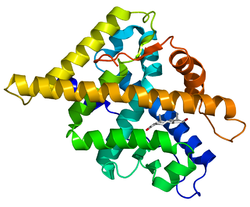雄激素受体
外观
| 雄激素受体 | |||||||||
|---|---|---|---|---|---|---|---|---|---|
 人类雄激素受体结合配体的结构域正与雄激素结合的晶体结构,受体NH2-端肽链、ar20-30及r1881 | |||||||||
| 鉴定 | |||||||||
| 标志 | Androgen_recep | ||||||||
| Pfam | PF02166(旧版) | ||||||||
| InterPro | IPR001103 | ||||||||
| |||||||||

雄激素受体(英语:androgen receptor,简称为AR),亦被称为NR3C4(核受体亚家族3,C组,成员4)是一类核受体[6],当雄性激素睾酮或二氢睾酮[7]在细胞质中与之结合后会使之激活继而转运进核内。雄激素受体与孕酮受体之间的关系很密切,高剂量的黄体制剂可阻断雄激素受体[8][9]。
雄激素受体的主要功能是作为调控基因表达的一种结合DNA的转录因子[10];然而雄激素受体也有其它方面的功能[11]。受雄激素调控的基因在男性性表型的发育及维持中起到重要作用。
另见
[编辑]参考文献
[编辑]- ^ PDB 2AM9; Pereira de Jésus-Tran K, Côté PL, Cantin L, Blanchet J, Labrie F, Breton R. Comparison of crystal structures of human androgen receptor ligand-binding domain complexed with various agonists reveals molecular determinants responsible for binding affinity. Protein Sci. May 2006, 15 (5): 987–99. PMC 2242507
 . PMID 16641486. doi:10.1110/ps.051905906.
. PMID 16641486. doi:10.1110/ps.051905906.
- ^ Quigley CA, De Bellis A, Marschke KB, el-Awady MK, Wilson EM, French FS. Androgen receptor defects: historical, clinical, and molecular perspectives. Endocr. Rev. June 1995, 16 (3): 271–321. PMID 7671849. doi:10.1210/edrv-16-3-271.
- ^ Gottlieb B, Lombroso R, Beitel LK, Trifiro MA. Molecular pathology of the androgen receptor in male (in)fertility. Reprod. Biomed. Online. January 2005, 10 (1): 42–8. PMID 15705293. doi:10.1016/S1472-6483(10)60802-4.
- ^ Choong CS, Wilson EM. Trinucleotide repeats in the human androgen receptor: a molecular basis for disease. J. Mol. Endocrinol. December 1998, 21 (3): 235–57. PMID 9845666. doi:10.1677/jme.0.0210235.
- ^ Meehan KL, Sadar MD. Androgens and androgen receptor in prostate and ovarian malignancies. Front. Biosci. May 2003, 8: d780–800. PMID 12700055. doi:10.2741/1063.
- ^ Lu NZ, Wardell SE, Burnstein KL, Defranco D, Fuller PJ, Giguere V, Hochberg RB, McKay L, Renoir JM, Weigel NL, Wilson EM, McDonnell DP, Cidlowski JA. International Union of Pharmacology. LXV. The pharmacology and classification of the nuclear receptor superfamily: glucocorticoid, mineralocorticoid, progesterone, and androgen receptors. Pharmacol. Rev. December 2006, 58 (4): 782–97. PMID 17132855. doi:10.1124/pr.58.4.9.
- ^ Roy AK, Lavrovsky Y, Song CS, Chen S, Jung MH, Velu NK, Bi BY, Chatterjee B. Regulation of androgen action. Vitam. Horm. Vitamins & Hormones. 1999, 55: 309–52. ISBN 978-0-12-709855-5. PMID 9949684. doi:10.1016/S0083-6729(08)60938-3.
- ^ Bardin CW, Brown T, Isomaa VV, Jänne OA. Progestins can mimic, inhibit and potentiate the actions of androgens. Pharmacol. Ther. 1983, 23 (3): 443–59. PMID 6371845. doi:10.1016/0163-7258(83)90023-2.
- ^ Raudrant D, Rabe T. Progestogens with antiandrogenic properties. Drugs. 2003, 63 (5): 463–92. PMID 12600226. doi:10.2165/00003495-200363050-00003.[永久失效链接]
- ^ Mooradian AD, Morley JE, Korenman SG. Biological actions of androgens. Endocr. Rev. 1987, 8 (1): 1–28. PMID 3549275. doi:10.1210/edrv-8-1-1.
- ^ Heinlein CA, Chang C. The roles of androgen receptors and androgen-binding proteins in nongenomic androgen actions. Mol. Endocrinol. 2002, 16 (10): 2181–7. PMID 12351684. doi:10.1210/me.2002-0070.
外部链接
[编辑]- GeneReviews/NCBI/NIH/UW entry on Androgen Insensitivity Syndrome (页面存档备份,存于互联网档案馆)
- OMIM entries on Androgen Insensitivity Syndrome
- GeneReviews/NIH/NCBI/UW entry on Spinal and Bulbar Muscular Atrophy, Kennedy's Disease, SBMA, X-Linked Spinal and Bulbar Muscular Atrophy (页面存档备份,存于互联网档案馆)
- OMIM entries on Spinal and Bulbar Muscular Atrophy, Kennedy's Disease, SBMA, X-Linked Spinal and Bulbar Muscular Atrophy
- 医学主题词表(MeSH):Androgen+Receptors
- Brinkmann AO. Androgen physiology: receptor and metabolic disorders (PDF). Robert McLachlan, editor (编). Endocrinology of Male Reproduction. Endotext.org. [2008-04-29]. (原始内容 (PDF)存档于2012-02-22).
- Gottlieb B. The Androgen Receptor Gene Mutations Database Server. McGill University. 2007-07-24 [2008-04-29]. (原始内容存档于2008-04-22).
- Thompson J. Molecular Mechanisms of Androgen Receptor Interactions (PDF). Helsinki University Biomedical Dissertations No. 80. University of Helsinki. 2006-09-30 [2008-04-29]. (原始内容 (PDF)存档于2008-04-06).



